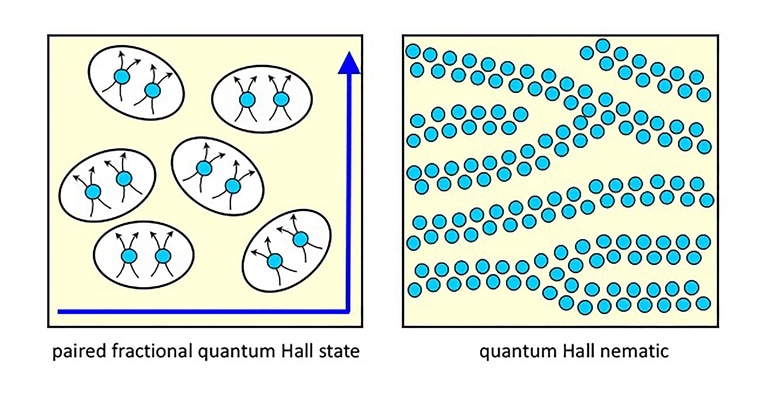Jun 21 2018
According to recent findings in Nature Communications, two different kinds of electron arrangements in a semiconductor - arranged in lines or paired as composite particles to interact with each other - offers new design possibilities for electronics.
 Two different kinds of electron arrangements in a semiconductor, paired as composite particles or lined-up, can interact with and tweak each other in the presence of hydrostatic pressure. (Purdue University image/Gábor Csáthy)
Two different kinds of electron arrangements in a semiconductor, paired as composite particles or lined-up, can interact with and tweak each other in the presence of hydrostatic pressure. (Purdue University image/Gábor Csáthy)
While it is not clear as what this means for semiconductor components, like those that transmit information across electronic devices, hydrostatic pressure can be applied to modify the interaction so that electrons that are coupled as composite particles can transition between paired (or "superconductor-like") and lined-up (or "nematic") phases. In addition, if these phases are forced to interact with each other, it indicates that they are capable of influencing each other's properties, such as stability. This presents new possibilities for manipulation in quantum computing and electronic devices.
You can literally have hundreds of different phases of electrons organizing themselves in different ways in a semiconductor. We found that two in particular can actually talk to each other in the presence of hydrostatic pressure.
Gábor Csáthy, Purdue Professor of Physics and Astronomy
Csáthy's team discovered that lattice of atoms in a semiconductor is compressed by hydrostatic pressure, which is 10,000 times stronger than ambient pressure, and as a result, this pressure affects the arrangement of electrons inside a two-dimensional (2D) electron gas hosted by the semiconductor. It is the strength of the pressure that establishes which electron arrangement is preferred and consequently modifies the switch between the lined-up and paired phases, thereby making them more customizable for a specific application. Among the two phases, the paired phase could support a specific type of quantum computing.
We can also tune the interaction by engineering the semiconductor. Say, for example, we grew a semiconductor with a particular width and electron density that we estimated could stabilize the nematic phase. Then we've tuned the electron-electron interaction as a result.
Gábor Csáthy, Purdue Professor of Physics and Astronomy
The semiconductor samples for this study were grown by Michael Manfra, Purdue professor of physics and astronomy, electrical and computer engineering and materials engineering, as well as Princeton University researchers Kenneth West and Loren Pfeiffer. Purdue Professor of Physics and Astronomy, Yuli Lyanda-Geller, provided theoretical support to understand the way these interactions between electrons occurred.
The U.S. Department of Energy, the National Science Foundation, and various fellowships supported the research.